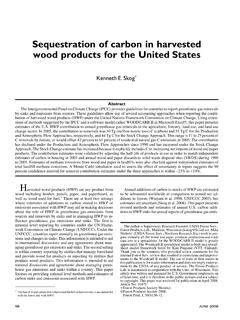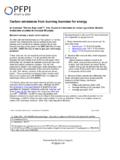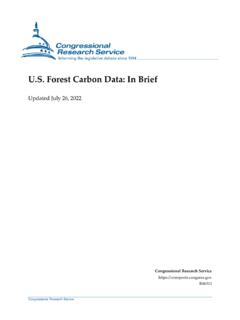Transcription of 2022 ICM Problem E - comap.com
1 | 2022 by COMAP, Inc. | | | | 2022 ICM Problem E: Forestry for carbon sequestration Background Climate change presents a massive threat to life as we know it. To mitigate the effects of climate change, we need to take drastic action to reduce the amount of greenhouse gases in the atmosphere. Simply r educing greenhouse gas emissions is not enough. We need to make efforts to enhance our stocks of carbon dioxide sequestered out of the atmosphere by the biosphere or by mechanical means. This process is called carbon sequestration . The biosphere sequesters carbon dioxide in plants (especially large plants like trees), soils, and water environments. Thus, forests are integral to any climate change mitigation effort. Forests sequester carbon dioxide in living plants and in the products created from their trees including furniture, lumber, plywood, paper, and other wood products.
2 These forest products sequester carbon dioxide for their lifespan. Some products have a short lifespan, while others have a lifespan that may exceed that of the trees from which they are produced. The carbon sequestered in some forest products combined with the carbon sequestered because of the regrowth of younger forests has the potential to allow for more carbon sequestration over time when compared to the carbon sequestration benefits of not cutting forests at all. At the global level, forest management strategies that include appropriate harvesting can be beneficial for carbon sequestration . However, overharvesting can limit carbon sequestration . Forest managers must find a balance between the value of forest products derived from harvesting and the value of allowing the forest to continue growing and sequestering carbon as living trees.
3 In doing so, they must consider many factors such as age and types of trees, geography, topography, and benefits and lifespan of forest products. The concerns of forest managers are not limited to carbon sequestration and forest products. They must make forest management decisions based on the many ways their forest is valued. These may include, but are not limited to, potential carbon sequestration , conservation and biodiversity aspects, recreational uses, and cultural considerations. Requirements The International carbon Management (ICM) Collaboration has been formed to develop guidance for forest managers around the world trying to figure out how to utilize and manage their forests. One-size-fits-all guidance is simply not possible as the make-up of forests, climates, populations, interests, and values vary widely around the world.
4 | 2022 by COMAP, Inc. | | | | Develop a carbon sequestration model to determine how much carbon dioxide a forest and its products can be expected to sequester over time. Your model should determine what forest management plan is most effective at sequestering carbon dioxide. The forest management plan that is best for carbon sequestration is not necessarily the one that is best for society given the other ways that forests are valued. Develop a decision model to inform forest managers of the best use of a forest. Your model should determine a forest management plan that balances the various ways that forests are valued (including carbon sequestration ). To better understand your model, consider some of the following questions, as well as questions of your own: * What is the spectrum of management plans that your decision model may suggest?
5 * Are there any conditions which would result in a forest that should be left uncut? * Are there transition points between management plans that apply to all forests? * How are characteristics about a specific forest and its location used to determine transition points between management plans? Apply your models to various forests. Identify a forest that your decision model would suggest the inclusion of harvesting in its management plan. How much carbon dioxide will this forest and its products sequester over 100 years? What forest management plan should be used for this forest? Why is this the best approach? Suppose the best management plan includes a time between harvests that is 10 years longer than current practices in the forest.
6 Discuss a strategy for transitioning from the existing timeline to the new timeline in a way that is sensitive to the needs of forest managers and all who use the forest. Some people believe we should never cut down any trees and yet you identified a forest that should include harvesting in its management plan. Write a one- to two-page non-technical newspaper article explaining why your analysis identified including harvesting in the management of this forest rather than it being left untouched. Ultimately, your article should convince the local community that this is the best decision for their forest. Your PDF solution of no more than 25 total pages should include: One-page Summary Sheet. Table of Contents. Your complete solution.
7 One- to two-page newspaper article. Reference List. Note: The ICM Contest has a 25-page limit. All aspects of your submission count toward the 25-page limit (Summary Sheet, Table of Contents, Reference List, and any Appendices). You must cite the sources for your ideas, images, and any other materials used in your report. | 2022 by COMAP, Inc. | | | | Glossary Biosphere: parts of Earth where you can find life. carbon sequestration : the process of capturing and storing carbon dioxide from the atmosphere. Forest Manager: an entity that controls and manages a forest and makes decisions about how it will be used. The Forest Manager may be an individual, government, corporation, or other public or private organization.
8 Forest Products: materials made from harvested wood, including, for example, furniture, lumber, plywood, paper, and wood pellets. Greenhouse Gases: gases in the atmosphere that trap heat and warm the planet. Examples of these gases include carbon dioxide, water vapor, methane, and nitrous oxide. Harvesting ( trees): the process of cutting down trees to be used as forest products. Forest Management: the process of managing a forest to include determining what trees should be cut down, which trees should be left standing, a timeline for harvesting the trees, and how to regenerate the forest.












